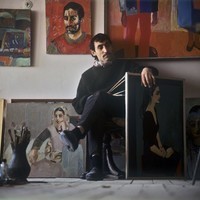Minas Avetisian
Video
Avetisian Minas Karapetovich is an Armenian painter, graphic artist, theatrical artist, an Armenian Honoured artist born in July 20, 1928 in the village of Jajur, Armenia.
Minas studied at Terlemezyan College of Fine Arts in Yerevan (1947–1952), Yerevan Fine Arts and Theater Institute (1952–1954), Painting, Sculpture and Architecture Institution Ilya Repin by name in Leningrad (1955–1959), where his main teacher was Boris Ioganson. From 1960 on Minas lived in Yerevan.
His first arts gallery took place in 1960, however, he got to be famous and known in 1962 after “Exhibition of Five” held in Yerevan. Numerous specialists and visitors to the exhibition appreciated greatly the well-established artist of bright individuality and his works.
Avetisian’s works characterized by seemingly wild brush work and strident colors gave new life to fauvism principles. You may as well easily trace some South Caucasus Middle Eve Arts traditions in his works. His works having a peculiar color saturation juxtaposed with an epic drama of bold shapes, nature paintings, self-portraits, symbolic countryside motives were interpreted at official exhibitions as a breakthrough to the freedom of esthetical self-expression. By this Avetisian got closer to the contemporary Russian rough style, even though in general he longed more to the French modern and early avant-garde style of early 20th.
Minas was also a success as a theatrical artist (theatre set design of Khachaturian's Gayane ballet at Opera and Ballet Theatre by Spendiarov Name, 1974) and as a monumental painter (factory interior wall-paintings in Leninakan- Gyumri, 1970-1974).
Minas travelled a lot around Armenia, searching for historical monuments, studying Armenian miniature works and works of the greatest Armenian artists, of Martiros Saryan in the first place. Saryan was Minas’s spiritual father. The young artist was a genuine successor of the great artist’s work and a symbol of a new development of national painting.
Following national traditions in painting, using means of expression found in ancient miniatures and considering the experience of famous artists, Minas, nevertheless, was never a blind copier. In his works he reflected the reality seen through his life perception and interpretation.
Unfortunately, many of his paintings were burned down in fire in 1972. In January 1 during the night time, while Avetisyan was in Jajur with his family, his studio in Yerevan was burned along with most of his best canvases.
Three years later, in 1975 Minas Avetisian died under the wheels of the car, which stopped off at the sidewalk. And the bad luck seemed to pursue him even after his death when part of his wall-paintings were destroyed during the earthquake in Leninakan (Gyumri) and razed to the ground Minas Avetisian’s museum in his native Jajur village.
In Armenia the name of Minas Avetisian is normally pronounced with affection. He committed his whole life (so tragically short) to Fine Arts. During 1960-1975 Minas managed to create over 500 canvases, big and small, and nearly the same amount of drawings, 20 big fresco’s and design projects for dozens of theatrical performances.
His works are introduced at Avetisian’s Home-Museum in Yerevan, Modern Arts Museum in Yerevan, Tretyakov Gallery in Moscow, Museum of Oriental Art in Moscow, as well as at numerous private collections in Armenia, Russia and other countries.

